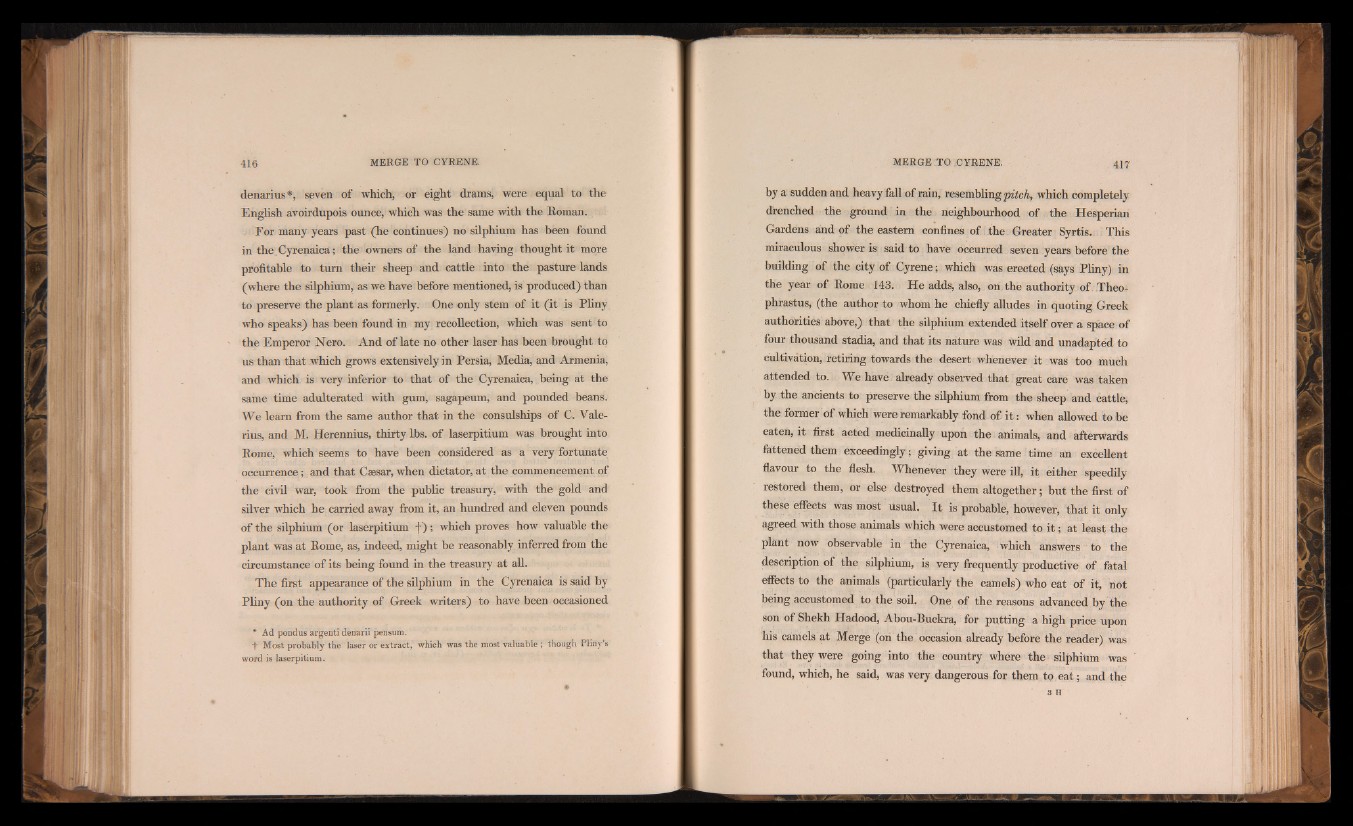
denarius*, seven of which, or eight drams, were equal to the
English avoirdupois ounce, which was the same with the Roman.
For many years past (he continues) no silphium has been found
in the Cyrenaica; the owners of the land having thought it more
profitable to turn their sheep and cattle into the pasture lands
(where the silphium, as we have before mentioned, is produced) than
to preserve the plant as formerly. One only stem of it (it is Pliny
who speaks) has been found in my recollection, which was sent to
the Emperor Nero. And of late no other laser has been brought to
us than that which grows extensively in Persia, Media, and Armenia,
and which is very inferior to that of the Cyrenaica, being at the
same time adulterated with gum, sagapeum, and pounded beans.
We learn from the same author that in the consulships of C. Valerius,
and M. Herennius, thirty lbs. of laserpitium was brought into
Rome, which seems to have been considered as a very fortunate
occurrence; and that Caesar, when dictator, at the commencement of
the civil war, took from the public treasury, with the gold and
silver which he carried away from it, an hundred and eleven pounds
of the silphium (or laserpitium f ) ; which proves how valuable the
plant was at Rome, as, indeed, might be reasonably inferred from the
circumstance of its being found in the treasury at all.
The first appearance of the silphium in the Cyrenaica is said by
Pliny (on the authority of Greek writers) to have been occasioned
* Ad pondus argenti denarii pensum.
f Most probably the laser or extract, which was the most valuable ; though Pliny’s
word is laserpitium.
by a sudden and heavy fall of rain, resembling pitch, which completely
drenched the ground in the neighbourhood of the Hesperian
Gardens and of the eastern confines of the Greater Syrtis. j This
miraculous shower is said to have occurred seven years before the
building of the city of Cyrene; which was erected (says Pliny) in
the year of Rome 143. He adds, also, on. the authority of Theophrastus,
(the author to whom he chiefly alludes in quoting Greek
authorities above,) that the silphium extended itself over a space of
four thousand stadia, and that its nature was wild and unadapted to
cultivation, retiring towards the desert whenever it was too much
attended to. We have already observed that great cate was taken
by the ancients to preserve the silphium from the sheep and cattle,
the former of which were remarkably fond of i t : when allowed to be
eaten, it first acted medicinally upon the . animals, and afterwards
fattened them exceedingly; giving at the same time an excellent
flavour to the flesh. Whenever they were ill, it either speedily
restored them, or else destroyed them altogether; but the first of
these effects was most usual. I t is probable, however, that it only
agreed with those animals which were accustomed to i t ; at least the
plant now observable in the Cyrenaica, which answers to the
description of the silphium, is very frequently productive of fatal
effects to the animals (particularly the camels) who eat of it, not
being accustomed to the soil. One of the reasons advanced by the
son of Shekh Hadood, Abou-Buckra, for putting a high price upon
his camels at Merge (on the occasion already before the reader) was
that they were going into the country where the silphium was
found, which, he said, was very dangerous for them to eat ; and the